Emerging technologies have driven innovation and progress in today's rapidly evolving digital landscape. From artificial intelligence and machine learning to blockchain and the Internet of Things, these technologies are reshaping industries across the globe. By staying informed and adopting emerging technologies, businesses can gain a competitive edge and position themselves for long-term success.
For startups and businesses venturing into the world of software development, Aloa is a game-changer. With our vast knowledge base and collaborative environment, Aloa empowers startups to leverage emerging technologies effectively. We work closely with startups to understand their unique requirements and goals, providing guidance and support in developing innovative software solutions. From conceptualization to implementation, we ensure your businesses have the right technologies to thrive in the dynamic digital landscape.
In this blog, we will dive deeper into what are emerging technologies. We will provide an overview of various technologies, highlighting their notable features and potential applications. Understanding these technologies is essential for startups to make informed decisions and harness their benefits effectively. Get ready to discover the exciting world of emerging technologies and how they can transform your business!
Let's get started!
An Overview of Emerging Technologies:
Emerging technologies refer to innovative advancements at the forefront of development, such as AI and quantum computing. They hold immense potential to reshape industries and enhance our lives, offering exciting possibilities and transformative impacts on various sectors. They are characterized by their disruptive nature and the transformative impact they can have on various sectors. Emerging technologies encompass a wide range of fields, including but not limited to tech, AI, IoT, virtual reality, automation, and more. These cutting-edge technologies offer new possibilities and use cases that were previously unimaginable. From email communication to robotics in manufacturing, emerging technologies are revolutionizing how we interact with the world.
The rapid pace of development and innovation in emerging technologies can be attributed to several factors. The influence of emerging technologies is further propelled by collaborations and knowledge-sharing across industries. Platforms like LinkedIn facilitate the exchange of ideas and expertise, leading to accelerated innovation. Emerging technologies hold the key to shaping our future. As technological advancements continue to unfold, it is vital for businesses, organizations, and individuals to stay informed about the latest trends and embrace these transformative technologies to thrive in the digital era.
Types of Emerging Technologies
Emerging technology continuously shapes our world, presenting new possibilities and transforming various industries. A vast array of emerging technologies is revolutionizing industries and reshaping how we live, work, and interact. Though not exhaustive, this list of emerging technologies provides a glimpse into some of the remarkable advancements poised to shape our future.
Artificial Intelligence (AI) and Natural Language Processing (NLP)
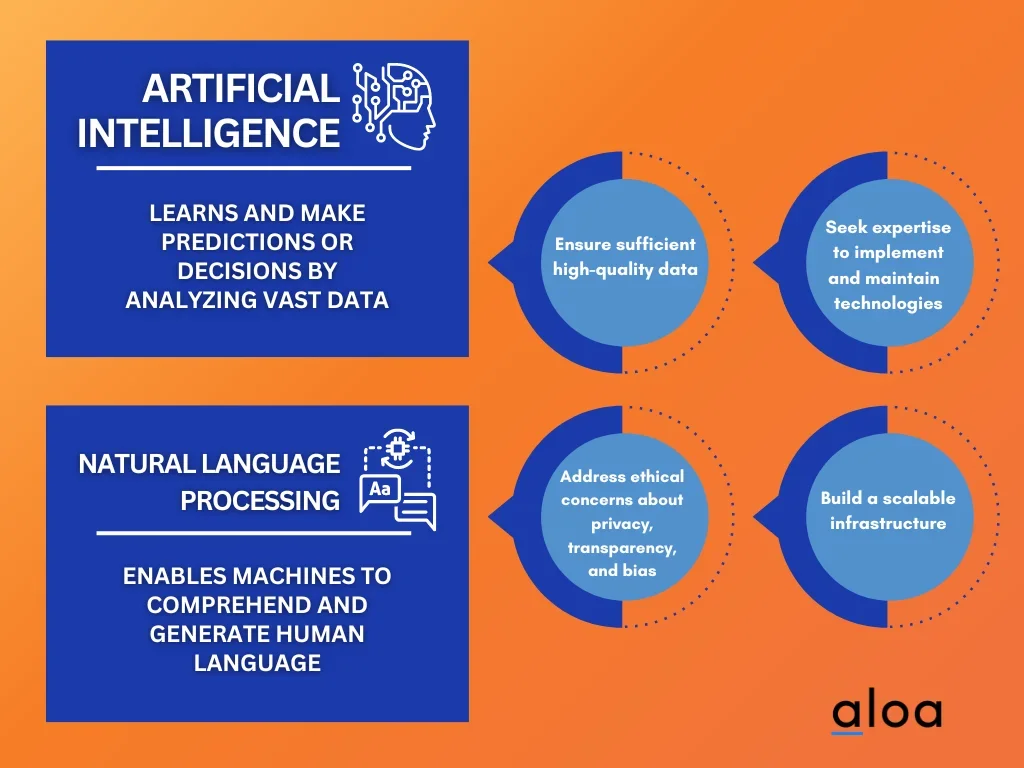
Artificial Intelligence (AI) is a subset of technology that aims to simulate human intelligence in machines. NLP, a key component of AI, focuses on understanding and processing human language. AI systems can learn and make predictions or decisions by analyzing vast data. NLP enables machines to comprehend and generate human language, facilitating communication between humans and computers. A prime example of the power of NLP is OpenAI's ChatGPT or GPT-4, a state-of-the-art language model that can generate human-like text based on the input it receives.
Notable Features
AI and NLP offer several notable features. AI can automate repetitive tasks, optimize decision-making processes, and improve operational efficiency. NLP enables sentiment analysis, language translation, chatbots, human-like text generation, and voice recognition, enhancing customer interactions and support.
Considerations for Integration in your Business
- Data Availability: Ensure sufficient high-quality data for AI algorithms to learn effectively.
- Expertise: Seek AI and NLP expertise to implement and maintain these technologies correctly.
- Ethical and Privacy Considerations: Address ethical concerns regarding data privacy, transparency, and bias in AI systems.
- Integration Challenges: Prepare for potential challenges in integrating AI and NLP with existing systems or processes.
Virtual Reality (VR)
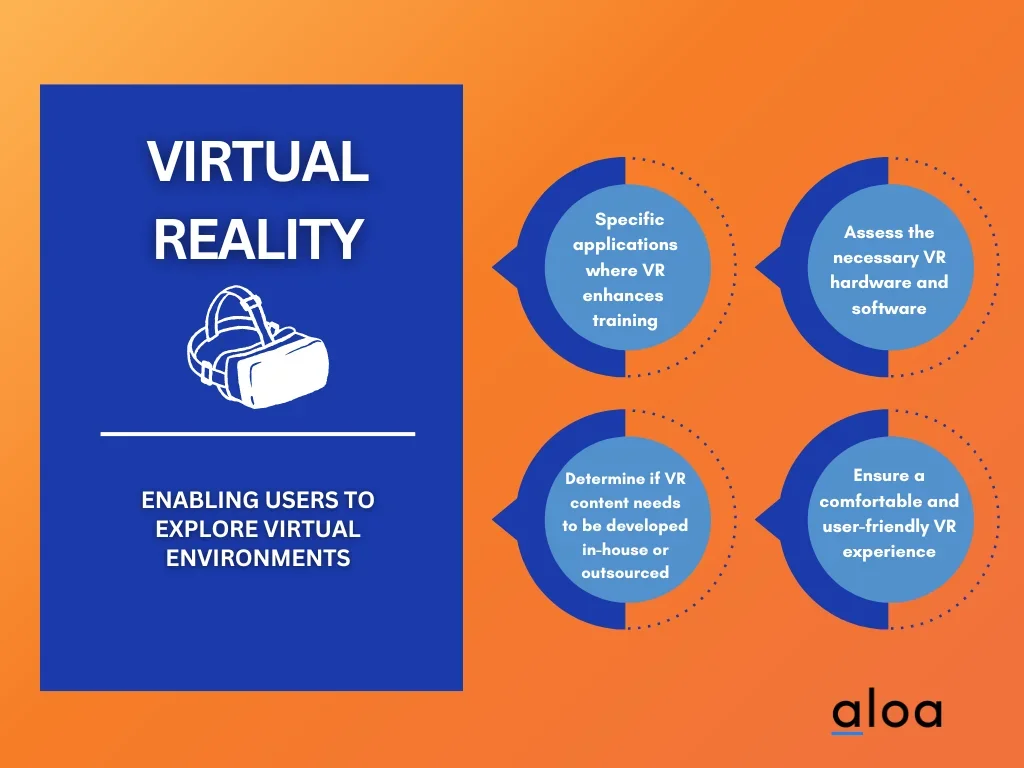
Virtual Reality (VR) is an immersive technology that simulates a realistic, computer-generated environment, allowing users to interact with a virtual world. VR utilizes headsets, controllers, and sensors to provide a highly immersive experience.
Notable Features
VR offers realistic visual and auditory experiences, enabling users to explore virtual environments, engage in interactive simulations, and experience virtual training programs.
Considerations for Integration in your Business
- Use Cases: Identify specific applications where VR can enhance training, product development, or customer experiences.
- Hardware and Software Requirements: Assess the necessary VR hardware and software, including headsets, controllers, and compatible systems.
- Content Creation: Determine if custom VR content needs to be developed in-house or outsourced.
- User Experience: Ensure a comfortable and user-friendly VR experience to maximize engagement and adoption.
Augmented Reality (AR)
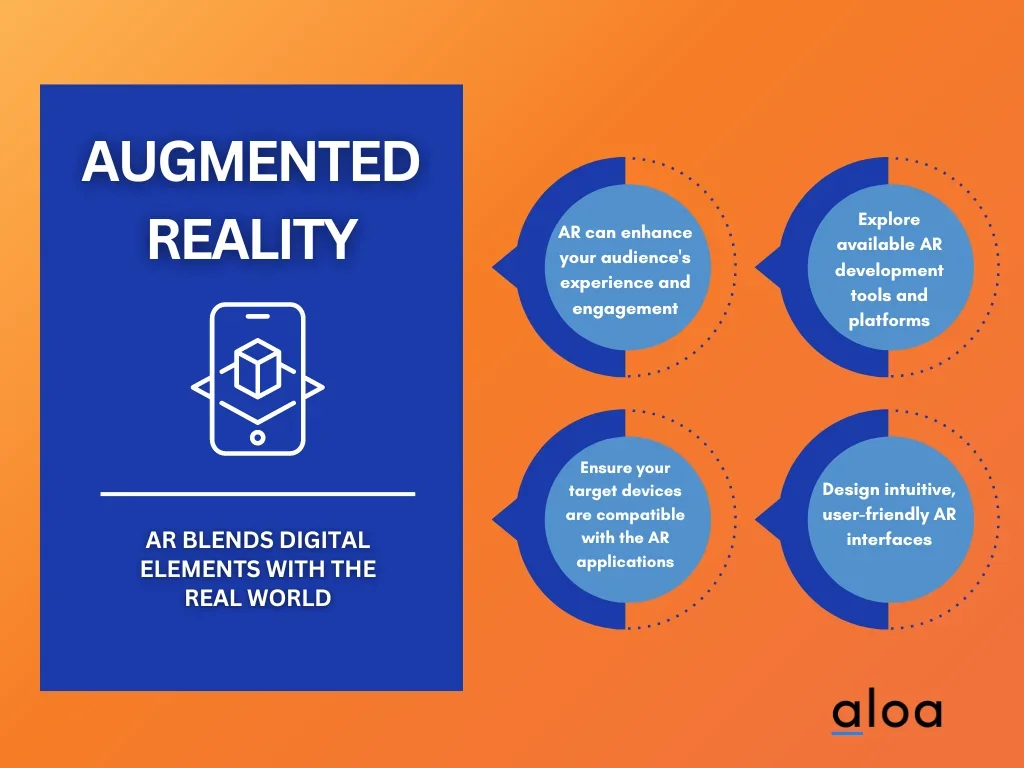
Augmented Reality (AR) blends digital elements with the real world, enhancing our perception of reality. AR technology overlays virtual information onto the user's real environment, typically through smartphone cameras or wearable devices.
Notable Features
AR enables interactive and dynamic visualizations, allowing users to overlay virtual objects, information, or graphics onto the real world. It enhances product visualization, remote assistance, and interactive marketing experiences. One notable example of a company leveraging AR technology is Video Bomb, one of our esteemed clients. Video Bomb harnesses the power of AR to create interactive and immersive experiences for its users.
Considerations for Integration in your Business
- Target Audience: Identify how AR can enhance your target audience's experience and engagement with your products or services.
- AR Development Tools: Explore available AR development tools and platforms to create AR experiences that align with your business goals.
- Hardware Compatibility: Ensure your target devices, such as smartphones or AR glasses, are compatible with the AR applications you plan to develop.
- User Interface Design: Design intuitive, user-friendly AR interfaces to provide a seamless, immersive experience.
Internet of Things (IoT)
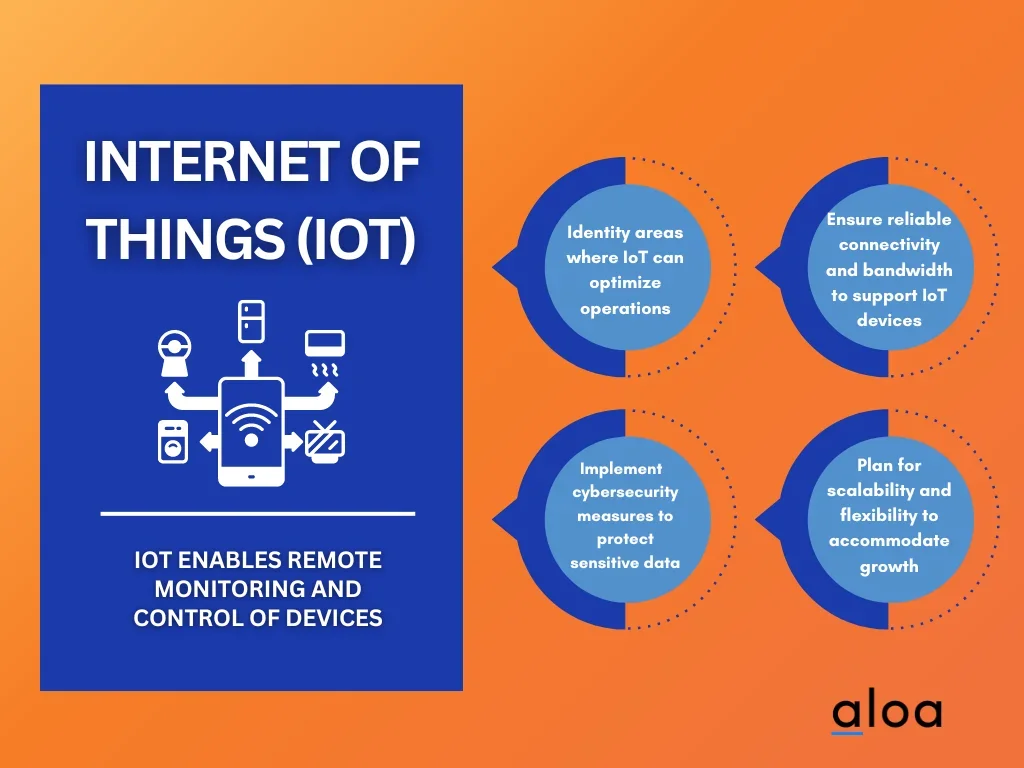
The Internet of Things (IoT) refers to the network of physical devices, vehicles, appliances, and other objects embedded with sensors, software, and connectivity capabilities. These interconnected devices collect and exchange data, enabling automation, monitoring, and control.
Notable Features
IoT enables remote monitoring and control of devices, data collection for analytics, predictive maintenance, and the creation of smart, interconnected systems.
Considerations for Integration in your Business
- Use Case Identification: Identity areas where IoT can optimize operations, improve efficiency, or enhance customer experiences.
- Connectivity and Bandwidth: Ensure reliable connectivity and sufficient bandwidth to support IoT devices' data transfer and communication needs.
- Data Security and Privacy: Implement robust cybersecurity measures to protect sensitive data and ensure user privacy in IoT ecosystems.
- Scalability: Plan for scalability and flexibility to accommodate the growing number of IoT devices and changing business needs.
Machine Learning and Deep Learning
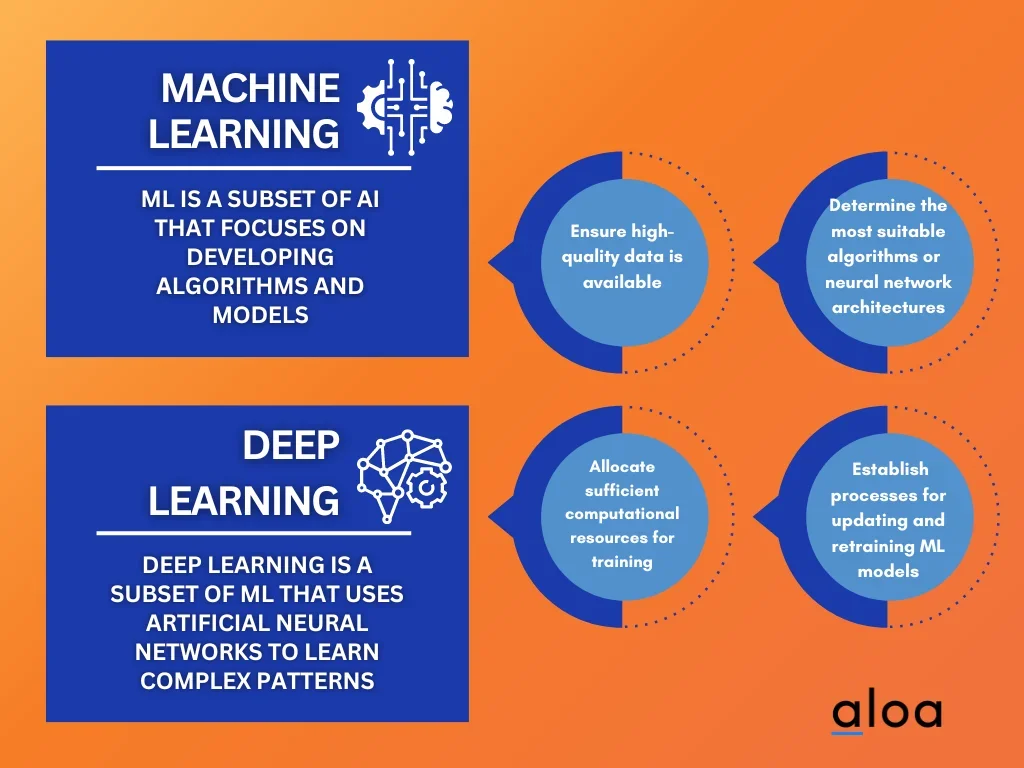
Machine Learning (ML) is a subset of AI that focuses on developing algorithms and models that enable computers to learn from data and make predictions or decisions without explicit programming. Deep Learning is a subset of ML that uses artificial neural networks to learn and extract complex patterns from large datasets.
Notable Features
Machine Learning and Deep Learning allow systems to analyze vast amounts of data, recognize patterns, and make accurate predictions. They have image and speech recognition applications, recommendation systems, and predictive analytics.
Considerations for Integration in your Business
- Data Quality and Availability: Ensure high-quality data is available to effectively train and validate ML models.
- Model Selection and Training: Determine the most suitable ML algorithms or deep neural network architectures for your specific use cases.
- Computational Resources: Allocate sufficient computational resources for training and inference tasks, which can be computationally intensive.
- Continuous Learning: Establish processes for updating and retraining ML models to adapt to changing data and improve performance over time.
Big Data
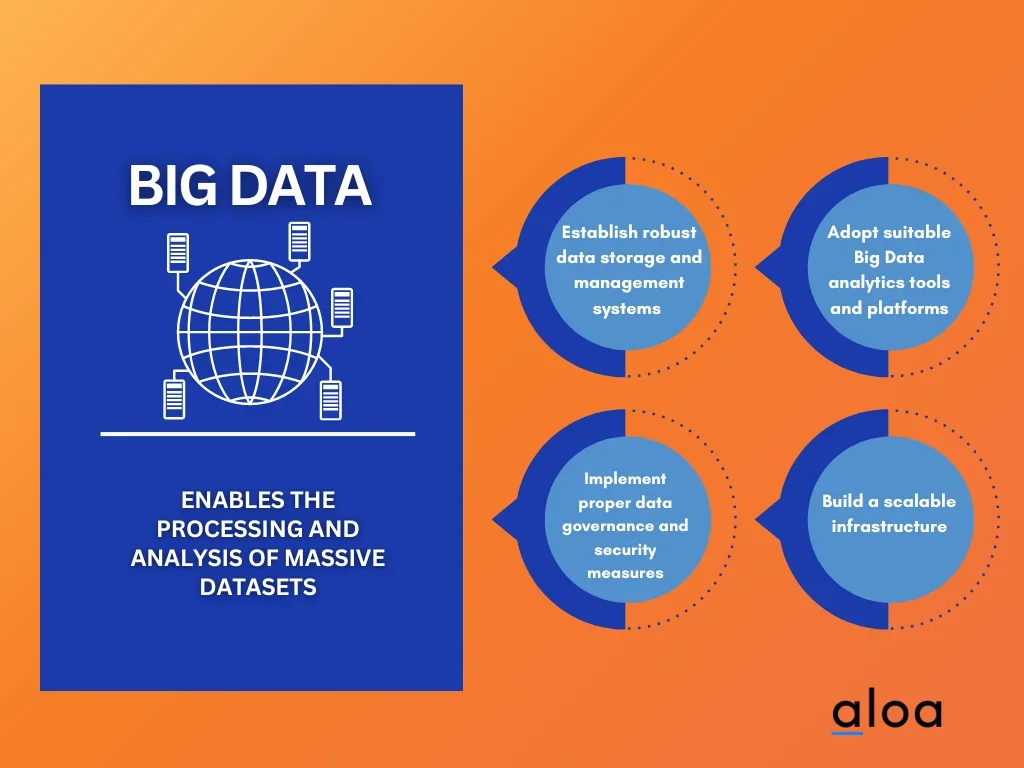
Big Data refers to vast and complex datasets that cannot be quickly processed or analyzed using traditional data processing methods. Big Data technologies involve techniques for capturing, storing, managing, and analyzing these vast volumes of data.
Notable Features
Big Data technologies enable the processing and analysis of massive datasets, uncovering valuable insights, patterns, and correlations that can drive informed decision-making.
Considerations for Integration in your Business
- Data Storage and Management: Establish robust data storage and management systems capable of handling large volumes of diverse data.
- Data Analytics Tools: Adopt suitable Big Data analytics tools and platforms to process and extract insights from your data.
- Data Governance and Security: Implement proper data governance and security measures to protect sensitive data and ensure compliance.
- Scalability and Infrastructure: Build a scalable infrastructure that can accommodate the growing volume and variety of data as your business expands.
Blockchain and Web3
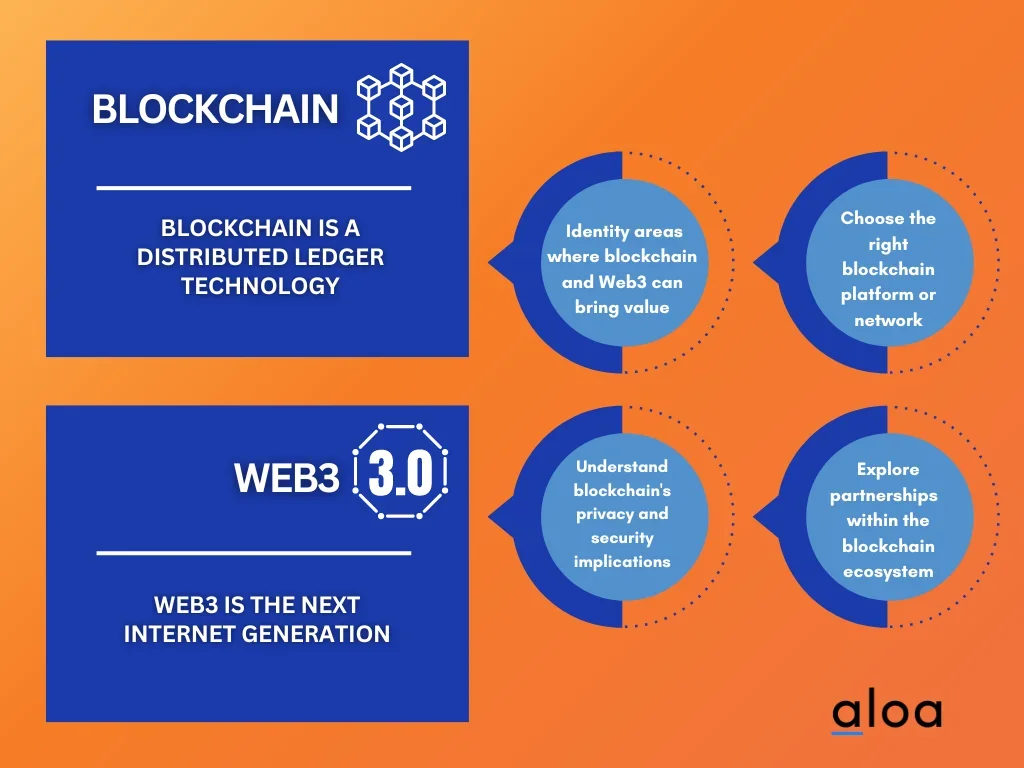
Blockchain is a distributed ledger technology that enables secure and transparent transactions and data storage. It provides a decentralized and tamper-resistant system for recording and verifying transactions. Web3 is the next internet generation, powered by blockchain and decentralized technologies.
Notable Features
Blockchain ensures immutability, transparency, and trust in transactions. It eliminates the need for intermediaries, reduces fraud, and enables secure and efficient peer-to-peer transactions. Web3 aims to decentralize the internet, giving users more control over their data and enabling new applications and business models.
Considerations for Integration in your Business
- Use Case Identification: Identity areas where the decentralized nature of blockchain and Web3 can bring value to your business, such as supply chain management, identity verification, or decentralized finance.
- Network Selection: Choose the right blockchain platform or network that aligns with your specific scalability, consensus mechanism, and smart contract capabilities requirements.
- Data Privacy and Security: Understand blockchain's privacy and security implications and implement appropriate measures to protect sensitive data and ensure compliance with regulations.
- Collaboration and Ecosystem: Explore partnerships and collaborations within the blockchain ecosystem to leverage existing infrastructure, tools, and expertise.
Quantum and Edge Computing
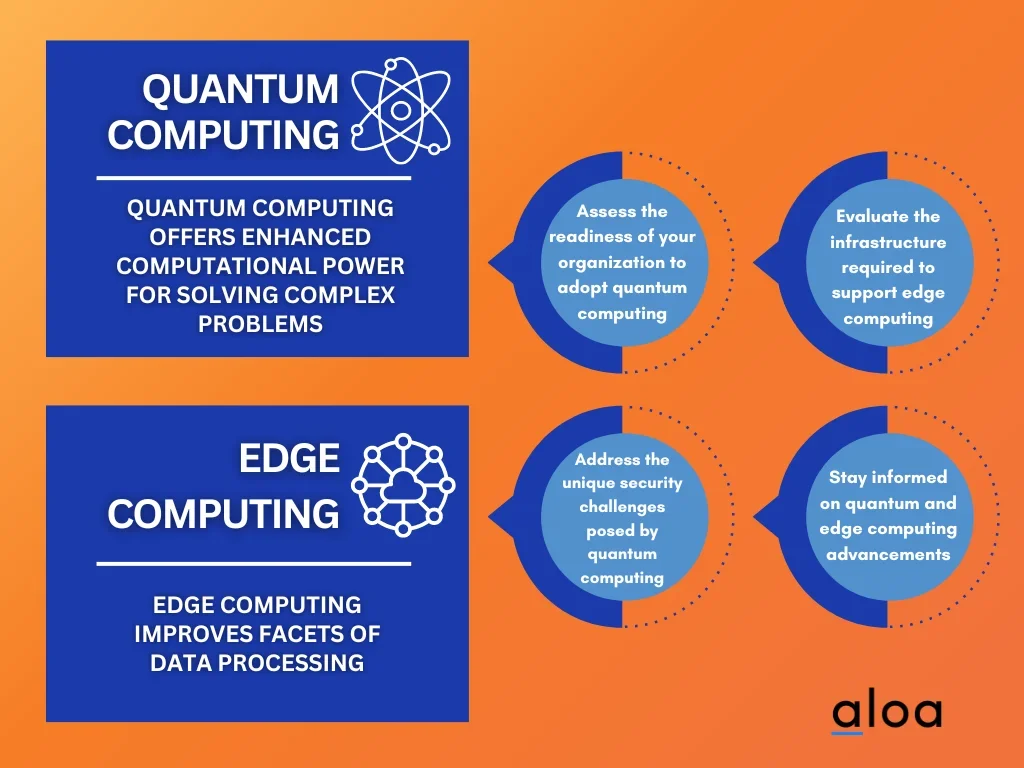
Quantum computing harnesses the principles of quantum mechanics to perform complex computations. It can solve problems exponentially faster than classical computers, particularly in cryptography, optimization, and quantum data loading. Edge computing involves processing data closer to its source, reducing latency, and enabling real-time processing at the network edge.
Notable Features
Quantum computing offers enhanced computational power for solving complex problems. Edge computing reduces latency, improves real-time processing capabilities, and enables decentralized data processing.
Considerations for Integration in your Business
- Quantum Computing Readiness: Assess the readiness of your organization to adopt quantum computing, considering factors such as available algorithms, expertise, and potential use cases.
- Edge Infrastructure: Evaluate the infrastructure required to support edge computing, including edge devices, networking capabilities, and data processing architectures.
- Data Security and Privacy: Address the unique security challenges posed by quantum computing and implement measures to protect sensitive data from quantum attacks. Additionally, ensure data privacy considerations are accounted for in edge computing environments.
- Exploration and Experimentation: Stay informed about quantum and edge computing advancements, collaborate with research institutions, and explore pilot projects to understand their potential impact on your business.
Biometrics
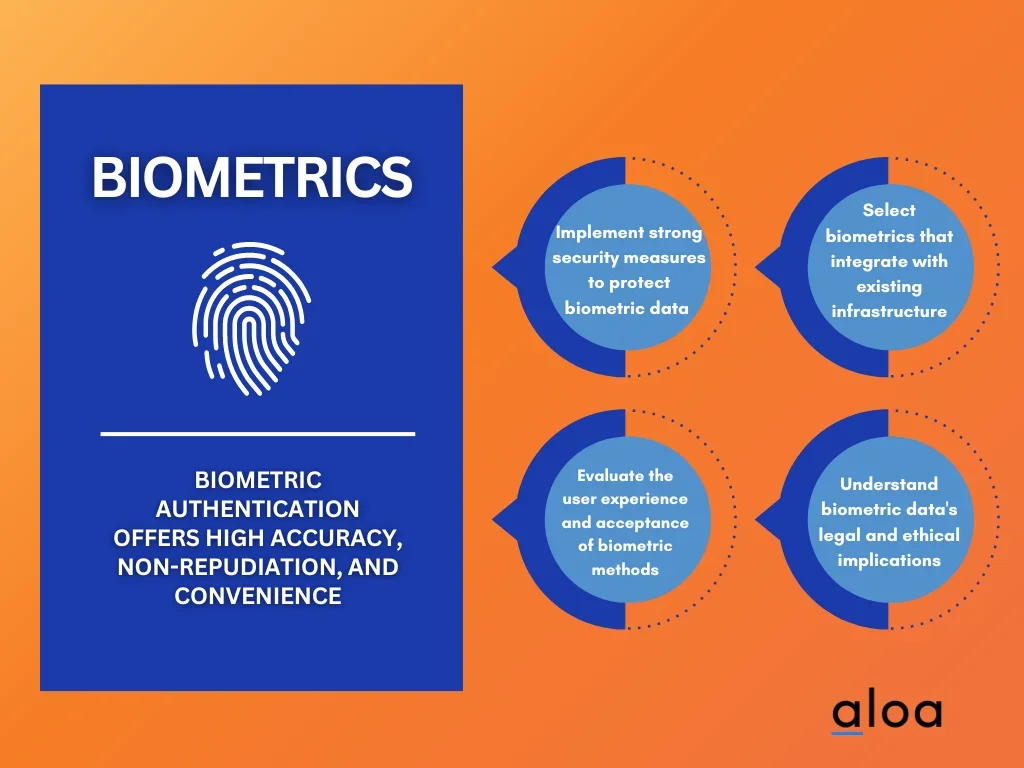
Biometrics involves using unique physical or behavioral characteristics, such as fingerprints, facial features, or voice patterns, for identification and authentication. Biometric technologies enhance security and convenience in various applications, including access control, identity verification, and payment systems.
Notable Features
Biometric authentication offers high accuracy, non-repudiation, and convenience. It provides a secure and efficient way to verify individual identities, reducing the reliance on passwords or traditional identification methods.
Considerations for Integration in your Business
- Data Privacy and Protection: Implement strong security measures to protect biometric data and comply with privacy regulations. Ensure that biometric templates are securely stored and encrypted.
- Integration and Compatibility: Select biometric systems and devices that integrate smoothly with existing infrastructure and systems. Consider scalability, interoperability, and compatibility with other authentication methods.
- Usability and User Acceptance: Evaluate the user experience and acceptance of biometric authentication methods, considering ease of use, speed, and user education.
- Legal and Ethical Considerations: Understand biometric data's legal and ethical implications, including obtaining appropriate consent and addressing potential bias or discrimination issues.
Energy
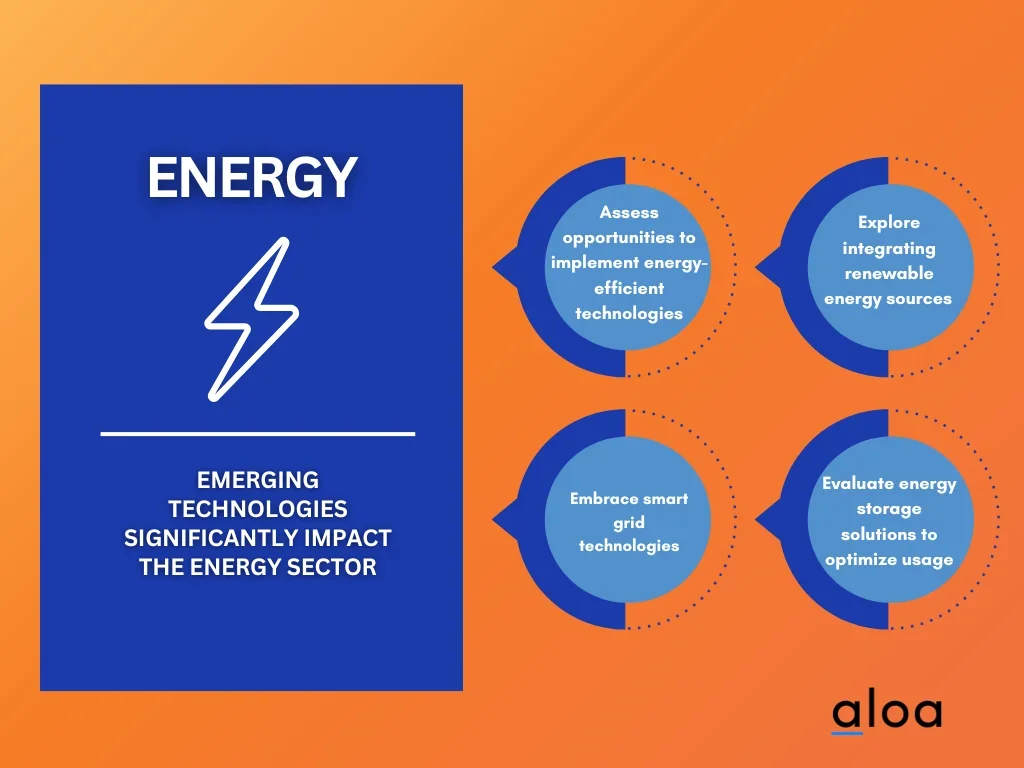
Emerging technologies significantly impact the energy sector, enabling more efficient energy generation, distribution, and consumption. Renewable energy sources, smart grids, and management systems are transforming the energy landscape.
Notable Features
Energy technologies focus on sustainability, efficiency, and renewable energy sources. They enable the integration of renewable energy into the grid, optimize energy usage, and provide intelligent control over energy systems through solutions like energy management system software.
Considerations for Integration in your Business
- Energy Efficiency Solutions: Assess opportunities to implement energy-efficient technologies, such as smart lighting, HVAC systems, and automated energy management systems. Tools like an HVAC cost estimator can help evaluate the financial impact of upgrading HVAC systems.
- Renewable Energy Adoption: Explore integrating renewable energy sources like solar panels or wind turbines to reduce reliance on traditional energy sources and lower carbon footprint.
- Grid Modernization: Embrace smart grid technologies that enable real-time monitoring, demand response, and efficient energy distribution.
- Energy Storage: Evaluate energy storage solutions, such as batteries or advanced storage technologies, to optimize energy usage and enable load balancing.
By understanding and embracing these emerging technologies, businesses can stay at the forefront of innovation, improve operational efficiency, enhance customer experiences, and seize new opportunities in the evolving digital landscape.
Impact of Emerging Technologies on Software Development: Strategies, Operations, and Trends
The emergence of new technologies significantly impacts software development strategies, operations, and trends. Here are some key impacts to consider:
- Increased Efficiency and Automation: Robotic Process Automation (RPA) and other automation tools streamline repetitive tasks, reducing manual effort and increasing productivity.
- Enhanced Security Measures: With the rising importance of cybersecurity, software development now focuses on implementing robust security measures to protect against cyber threats and ensure data privacy.
- Integration of Quantum Computing: Quantum computers are poised to revolutionize computing capabilities in the coming years. Software development strategies will need to adapt to harness the power of quantum computing for complex problem-solving and optimization tasks.
- Adoption of Agile and DevOps: Software development practices have shifted towards Agile methodologies and DevOps approaches, enabling faster development cycles, continuous integration, and seamless collaboration between development and operations teams.
- Embracing Digital Transformation: Emerging technologies drive digital transformation initiatives, prompting businesses to modernize their software development strategies to leverage cloud computing, big data analytics, and other digital technologies.
- Incorporating Blockchain Technology: Blockchain technology has the potential to enhance transparency, security, and trust in software development. Integrating blockchain into software solutions can enable decentralized systems, smart contracts, and secure transactions.
- Keeping Pace with Technology Trends: To remain competitive, software developers must stay updated with the latest technology trends. Keeping an eye on emerging technologies and their potential applications ensures software development strategies align with industry advancements.
These impacts highlight the transformative nature of emerging technologies on software development strategies, operations, and trends. As business leaders, CEOs, and software development teams adapt to these changes, they can unlock new opportunities and stay at the forefront of innovation in the dynamic digital landscape.
Key Takeaways
Integrating emerging technologies in business requires careful consideration of specific challenges and opportunities within your industry. Embrace a culture of innovation and continuous learning to support integrating emerging technologies.
Keeping up with what are emerging technologies is crucial for businesses to stay competitive, drive innovation, and adapt to the rapidly evolving digital landscape. By staying informed about the latest advancements, businesses can harness the transformative power of emerging technologies to gain a strategic advantage and unlock new opportunities.
Explore and consider these emerging technologies in the context of your business. Reach out to [email protected] for expert guidance and support in effectively integrating these technologies. Embrace emerging technologies' possibilities and position your business for success in the digital era.

